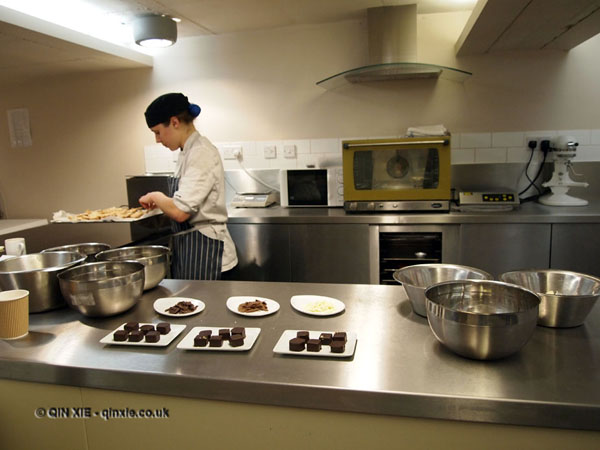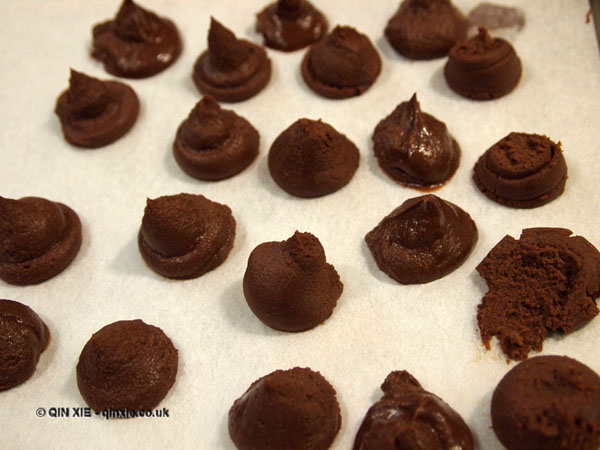Published on Foodepedia on 11th October 2010:
Many of you chocolate lovers will know that Chocolate Week is coming up. From the 11th of October, Britain will be whipped into a chocolate consumption frenzy, ending with Chocolate Unwrapped at the Vinopolis on 16th and 17th of October. You can read our Chocolate Week guide here.
To help with the indulgence, the Foodepedia team (and a few lucky volunteers) gathered around the office to try out some truly delicious chocolates to give you our pick of Chocolate Week consumables. We want to thank all the chocolatiers who have sent in samples to help us decide and the choice has been by no means easy. And you know it was that good when it’s taken us almost three weeks to come up with the goods!
Chocolates truffles
We tried: Artisan du Chocolat Truffles, Booja Booja Around Midnight Espresso, Booja Booja Italian Hazelnut, Harrods Chocolatier Milk Chocolate Truffles, Harrods Chocolatier Pink Chocolate Truffles, Hotel Chocolat Classic Champagne Truffles, Hotel Chocolat Pink Champagne Truffles, Paul A Young Los Ancones Truffles.
We loved: Paul A Young Los Ancones Truffles
Because… it’s the classic truffle with an almost liquid centre which tastes like freshly made real hot chocolate. These truffles are rich, dark and delicious. We also detected a hint of nuttiness which made the flavours all the more intense.
You can buy it from: Paul A Young.
Retro chocolates
We tried: Guylian Chocolate Seashells, Harrods Milk Chocolate Pastilles, Harrods White Chocolate Pastilles, Neuhaus Lady Chefs.
We loved: Neuhaus Lady Chefs
Because… the packaging is so beautifully retro, and it tastes good too. Neuhaus is of course one of the most famous Belgian chocolatiers. The selection comes in a pink faux-leather case and the chocolates inside are all flavours created by female chefs. The girls in the team can’t imagine receiving a better chocolate gift.
You can buy it from: Harrods who are the exclusive stockists in the UK.
Dark chocolates
We tried: Amedei 63, Artisan du Chocolat Jamaica 72% Cocoa, Artisan du Chocolat Vietnam 72% Cocoa, Harrods Chocolatier Dark Chocolate 67%, Hotel Chocolat Rabot Estate 65%,
We loved: Amedei 63
Because… it’s smooth and velvety without the bitter after taste so often found in dark chocolate. The fact that the ingredients are from some of the world’s most sought after beans just makes it even better.
You can buy it from: Harvey Nichols, Chocolate Trading co.
Gourmet chocolates
We tried: Demarquette The Orient Collection, Neuhaus Lady Chefs, Paul A Young Sea Salt Caramels, Sir Hans Sloane.
We loved: Sir Hans Sloane
Because… it tastes intensely chocolaty, has beautifully classic packaging and the chocolates are easy to identify. We loved the fact that the chocolates are labelled in situ so there was no faffing about with paper guides. The flavours weren’t adventurous but they were good.
You can buy it from: Sir Hans Sloane, Harrods.
Milk chocolates
We tried: Artisan du Chocolat Jamaica 40% Cocoa, Cocoa Bean Chocolate co Irish Honey, Harrods Chocolatier Milk Chocolate 41%, Paul A Young Autumn Bar.
We loved: Artisan du Chocolat Jamaica 40%
Because… it’s not too sweet but very chocolatey. It’s plain, simply and good quality chocolate but there was also a hint of something we can’t quite place. It’s also available in a dark 72%.
You can buy it from: Artisan du Chocolat, Selfridges.
Cooking chocolates
We tried: Amedei Chuao, Hotel Chocolat Hacienda Iara 100%, Hotel Chocolat Hacienda Iara 80%, Valrhona Abinao, Willie’s Supreme Cacao Hacienda El Tesoro.
We loved: Amedei Chuao
Because… you can cook with it but it’s equally good as a nibble with the perfect balance between sweetness and bitterness. It’s really hard to pick the one we loved the most when all the ones that we tried were of such a high quality – as it should be if you’re cooking with it. But we know that Amedei chocolates are ethically sourced and they only use the highest quality beans. Plus, it helps if you can eat it as you cook.
You can buy it from: Harvey Nichols, William Curley.
Flavoured chocolates
We tried: Hotel Chocolat Rocky Road Slab, Paul A Young Aztec Emperor, Paul A Young Pina Colada, Cocoa Bean Chocolate co G&T, Cocoa Bean Chocolate co Rose & Pistachio, Cocoa Bean Chocolate co Sea Salt, Cocoa Bean Chocolate co Lime Zest & Black Pepper.
We loved: Hotel Chocolat Rocky Road Slab
Because… we couldn’t imagine a chocolate which has more flavours or textured incorporated into one. The Rocky Road Slab is a mixture of dark, milk and white chocolates plus cookies and rice puffs. There is something for everyone in this one bar.
You can buy it from: Hotel Chocolat
Chocolates with filling
We tried: Demarquette The Orient Collection, Neuhaus Lady Chefs, Paul A Young Seasalt Caramels, Paul Wayne Gregory Chocolate Lollies, Sir Hans Sloane.
We loved: Paul Wayne Gregory Chocolate Lollies.
Because… it’s outrageously different, and in a good way. The outer shell is a mixture of deliciously dark chocolate mixed with exploding candy which melts away to an intense seasalt caramel centre. The feel and taste is just incredible.
You can buy it from: Paul Wayne Gregory.
So, we hope you enjoyed our little round up. Do let us know your Chocolate Week favourites too.


